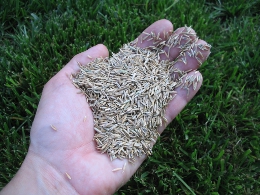If you had to pick between establishing your new lawn with sod or grass seed,which would you choose? Sod has the obvious advantage of being “instant,” but seed has some advantages you may not know about. Here are the three biggest advantages to plant grass seed instead of using sod to establish a new lawn:
- Less expensive. Let’s say that you have a yard measuring 2,000 square feet that you would like to turn into a lawn. How much would it cost to lay sod over the entire area? The least expensive sod you will probably find is around 30 cents per square foot. That means you would be paying $600 for a new lawn—and it might not even be worth the investment, depending on the quality of the grass seed it was established from. Additionally, for best results sod should be laid within 24 hours of it being cut, and it isn’t likely that the sod on sale in your garden supply store is that fresh. You would be better off ordering sod from a professional supplier who can guarantee when it was harvested. That, of course, increases the price of the sod, to perhaps as much as $1.00 per square foot. That 2000 square foot lawn might cost as much as $2,000 to establish from sod. Grass seed at NaturesSeed.com ranges from about $0.02 to $0.08 per square foot of coverage, resulting in a savings of 90-95% over sod.
- More choices. Sod is a convenient and fast way to establish a lawn, but it is basically a one-size-fits-all product. Sod lawns usually contain only one species of grass and no different varieties of that grass species—this is known as a monoculture, which can make your lawn more susceptible to drought, disease, and stress. The great thing about seeds is that they are so easy to mix together, and mixes of different seeds are the best way to make your lawn more versatile and resistant to poor environmental conditions. For example, Nature’s Seed offers a Sun & Shade Grass Seed Blend that can handle full sun to heavy shade. It contains 4 different species of grass: Kentucky bluegrass, perennial ryegrass, chewings fescue, and hard fescue. If you’re interested in an alternative lawn option, Nature’s Seed has a Low Maintenance Grass Blend which contains unique grass types that you wouldn’t find in sod products. Even blends with only one grass species will usually contain different varieties to increase diversity, such as in the Triple Play Blend, which contain 3 varieties of turf-type tall fescue. Establishing a lawn from these seed products may take longer than sod, but the care you take in selecting the perfect blend for your needs will be well worth it in the long run.
- Less labor intensive.
Laying sod is not a solitary job. You will first need to figure out to transport it—do you have a vehicle big enough to fit all of your sod pieces, or will you need them delivered to you? You will also need the muscle of more than one person to lay it on your yard. Most sod pieces are too big to be carried by one person, and they could break. Often people will hire a professional to lay the sod for them, which significantly increases the cost of the lawn project. In short, laying sod can get complicated, and simplifying it by using labor can get expensive.
What’s involved in seeding a lawn? You buy the appropriate amount of seed from a professional supplier. You prepare the soil appropriately, and you spread half the seed on the lawn widthwise, and half of the seed lengthwise. There’s more to it than that, of course, but with some background research it can certainly be done by one person in the space of an afternoon. And with all the money you saved by buying grass seed, you could choose to have professional do the seeding for you.



 Laying sod is not a solitary job. You will first need to figure out to transport it—do you have a vehicle big enough to fit all of your sod pieces, or will you need them delivered to you? You will also need the muscle of more than one person to lay it on your yard. Most sod pieces are too big to be carried by one person, and they could break. Often people will hire a professional to lay the sod for them, which significantly increases the cost of the lawn project. In short, laying sod can get complicated, and simplifying it by using labor can get expensive.
Laying sod is not a solitary job. You will first need to figure out to transport it—do you have a vehicle big enough to fit all of your sod pieces, or will you need them delivered to you? You will also need the muscle of more than one person to lay it on your yard. Most sod pieces are too big to be carried by one person, and they could break. Often people will hire a professional to lay the sod for them, which significantly increases the cost of the lawn project. In short, laying sod can get complicated, and simplifying it by using labor can get expensive.